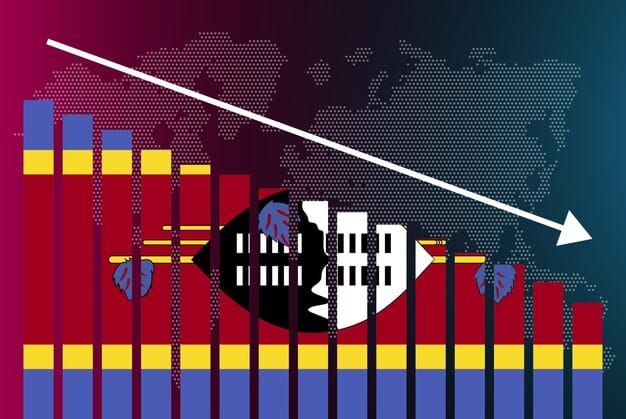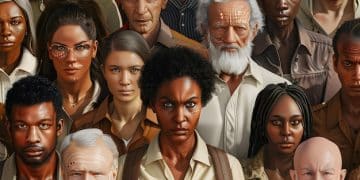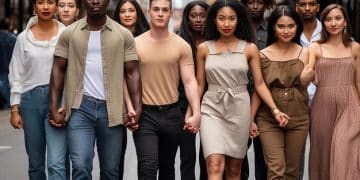Racial Shifts in the US by 2030: Implications for Representation

What are the projected changes in racial demographics in the US by 2030 and what do they mean for representation? By 2030, the US is projected to become more racially and ethnically diverse, with significant growth in Hispanic, Asian, and multiracial populations, potentially altering the landscape of political and social representation.
The United States is on the cusp of a significant demographic transformation. Understanding what are the projected changes in racial demographics in the US by 2030 and what do they mean for representation is crucial for navigating the shifting social and political landscape. Let’s delve into the numbers and explore what they signify for the future.
The Shifting Sands: Projecting Racial Demographics in 2030
Predicting the future is never an exact science, but demographic projections offer valuable insights into the potential makeup of the United States in 2030. These projections, often based on current trends in birth rates, immigration patterns, and mortality rates, paint a picture of a nation that is becoming increasingly diverse.
Understanding these shifts is not just an academic exercise; it has profound implications for everything from political representation to economic policy to social justice.
Key Projections for 2030
Several key trends are expected to shape the racial demographics of the US by 2030. Here’s a closer look at some of the most significant projections:
- Growth of Hispanic Population: The Hispanic population is projected to continue its rapid growth, becoming one of the largest minority groups in the country.
- Rise of Asian Americans: Asian Americans are also expected to experience substantial growth, driven by both immigration and birth rates.
- Increasing Multiracial Identification: More Americans are identifying as multiracial, reflecting changing attitudes and increasing intermarriage rates.
- Declining White Non-Hispanic Percentage: While still the largest racial group, the percentage of White non-Hispanics is projected to decline.
These projections are sourced from various studies conducted by the US Census Bureau, Pew Research Center, and other reputable demographic research institutions.
In summary, the US in 2030 is expected to be more racially and ethnically diverse than ever before, with significant growth in minority populations and a corresponding decline in the percentage of White non-Hispanics.

Representation Matters: The Political Landscape in 2030
As the racial demographics of the US continue to evolve, so too must the systems of political representation. Fair and equitable representation is essential for ensuring that the voices of all Americans, regardless of their race or ethnicity, are heard in the halls of power.
However, achieving truly representative democracy is not simply a matter of counting heads. It requires addressing systemic barriers that have historically hindered marginalized communities from fully participating in the political process.
Challenges to Fair Representation
Several factors can impede fair representation for minority groups, including:
- Gerrymandering: The practice of drawing electoral district boundaries to favor one political party or group can dilute the voting power of minority communities.
- Voter ID Laws: Strict voter ID laws can disproportionately disenfranchise minority voters who may lack the required identification.
- Felony Disenfranchisement: Laws that prevent convicted felons from voting, even after they have served their time, can disproportionately impact minority communities due to disparities in the criminal justice system.
These challenges highlight the need for proactive measures to ensure that all Americans have an equal opportunity to participate in the democratic process.
Genuine representation requires ongoing vigilance and advocacy to address systemic barriers and ensure that all voices are heard.
The Economic Implications of Demographic Change
The projected changes in racial demographics in the US by 2030 are not just about politics; they also have significant economic implications. As the population becomes more diverse, businesses and policymakers alike must adapt to the changing needs and preferences of consumers and workers.
Moreover, addressing economic disparities between racial groups is crucial for ensuring that all Americans have the opportunity to thrive in the 21st century economy.
Opportunities and Challenges
The changing demographics present both opportunities and challenges for the US economy:
- Growing Consumer Markets: The increasing purchasing power of minority communities represents a significant opportunity for businesses that are willing to cater to their unique needs and preferences.
- Labor Force Diversity: A more diverse labor force can bring new perspectives and skills to the workplace, fostering innovation and productivity.
- Skills Gap: Addressing the skills gap among minority workers is essential for ensuring that they have access to good-paying jobs in the growing sectors of the economy.
By investing in education, job training, and other programs that support economic mobility, the US can ensure that all Americans benefit from the changing demographics.
In conclusion, demographic shifts present a variety of challenges that must be addressed to create a society where everyone has the chance to succeed financially.

Intersectionality and Identity: Beyond Simple Demographics
While demographic projections provide a broad overview of population trends, it’s important to recognize that race is not the only factor that shapes a person’s identity and experiences. Intersectionality, the concept that different forms of discrimination can overlap and compound one another, is crucial for understanding the complexities of identity in the 21st century.
For example, a person’s gender, sexual orientation, socioeconomic status, and disability status can all intersect with their race to create unique challenges and opportunities.
Understanding Intersectionality
To gain a truly nuanced understanding of identity, it’s essential to consider the interplay of multiple factors, such as:
- Gender and Race: Women of color often face unique challenges related to both sexism and racism.
- Sexual Orientation and Race: LGBTQ+ people of color may experience discrimination based on both their sexual orientation and their race.
- Socioeconomic Status and Race: Poverty and lack of access to resources can disproportionately affect minority communities.
By recognizing the complexities of intersectionality, policymakers and community leaders can develop more effective strategies for promoting equity and inclusion.
Considering multiple identities is key when fostering an inclusive enviornment.
Education and Awareness: Building a More Inclusive Future
As the US becomes more racially and ethnically diverse, it’s more important than ever to promote education and awareness about different cultures, histories, and perspectives. By fostering a greater understanding of diversity, we can build a more inclusive and welcoming society for all.
This includes teaching accurate and comprehensive histories in schools, promoting cross-cultural dialogue and understanding in communities, and challenging stereotypes and biases in the media.
Strategies for Promoting Inclusion
Several strategies can be used to promote education and awareness about diversity:
- Curriculum Reform: Updating school curricula to include the histories and contributions of diverse groups.
- Community Workshops: Organizing workshops and training sessions to promote cross-cultural understanding.
- Media Literacy: Teaching people how to critically analyze media representations of different racial groups.
These strategies can help to create a more informed and engaged citizenry, better equipped to address the challenges and opportunities of a diverse society.
Investing in education will allow future generations to embrace the changing racial demographics.
Policy Recommendations for a Changing America
The projected changes in racial demographics in the US by 2030 necessitate a re-evaluation of existing policies and the development of new ones to ensure fairness, equity, and opportunity for all. These policy recommendations should address a range of issues, including voting rights, economic opportunity, and access to education and healthcare.
By implementing these policies, the US can create a more just and equitable society where everyone has the chance to reach their full potential.
Key Policy Areas
Several key policy areas require attention in light of the changing demographics:
- Voting Rights: Strengthening voting rights protections to ensure that all citizens have an equal opportunity to participate in the democratic process.
- Economic Opportunity: Investing in programs that promote economic mobility for minority communities, such as job training, affordable housing, and access to capital.
- Education: Ensuring that all students, regardless of their race or ethnicity, have access to high-quality education from early childhood through college.
These policy recommendations represent a starting point for creating a more inclusive and equitable society in a changing America.
Ultimately, embracing diversity in policy decisions is essential for all parties involved.
| Key Point | Brief Description |
|---|---|
| 📈 Demographic Shifts | US will be more diverse by 2030, with rise in Hispanic, Asian, and multiracial populations. |
| 🗳️ Representation Challenges | Gerrymandering and voter ID laws can hinder fair representation for minorities. |
| 💼 Economic Impact | Diversity boosts consumer markets and workforce; skills gap needs addressing. |
| 🤝 Policy Changes | Strengthening voting rights, promoting economic mobility, and ensuring equal access to education. |
Frequently Asked Questions
▼
The main drivers include birth rates, immigration patterns, and mortality rates. Minority populations, particularly Hispanic and Asian, tend to have higher growth rates compared to White non-Hispanics.
▼
Gerrymandering can dilute the voting power of minority communities by drawing district lines that split them up or pack them into a single district, limiting their ability to elect representatives of their choice.
▼
A more diverse population can lead to growing consumer markets and a more innovative workforce. However, it also presents challenges like addressing skills gaps and economic disparities among different racial groups.
▼
Policy changes include strengthening voting rights protections, investing in economic mobility programs, and ensuring equal access to education and healthcare for all, regardless of race or ethnicity.
▼
Communities can promote inclusion by reforming school curricula, organizing cross-cultural workshops, and promoting media literacy to challenge stereotypes and biases about different racial groups.
Conclusion
The projected changes in racial demographics in the US by 2030 present both challenges and opportunities. By understanding these shifts and addressing the systemic barriers that hinder fair representation and economic opportunity, the US can build a more inclusive and equitable society for all its citizens.





